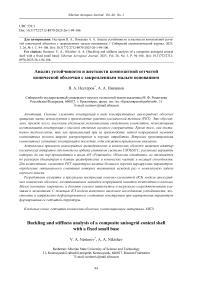Buckling and stiffness analysis of a composite anisogrid conical shell with a fixed small base
Автор: Nesterov V.A., Nikishev A.A.
Журнал: Siberian Aerospace Journal @vestnik-sibsau-en
Рубрика: Aviation and spacecraft engineering
Статья в выпуске: 1 vol.26, 2025 года.
Бесплатный доступ
Power elements of structures in the form of structural anisogrid shells of rotation are often used in the production of rocket and space technology. This is due, first of all, to high specific mechanical properties of composites, which allow to manufacture structures with a high degree of weight perfection. In addition, they are quite technological, as the method of continuous winding of composite fibers used in their production is widespread and well developed. In recent years, close attention has been paid to the design of composite mesh structures. An actual example of anisogrid cylindrical and conical shells is a spacecraft adapter for GLONASS sa-tellites orbit launching, different variants of which are still produced in the workshops of Reshetnev JSC. The shells are of the same type, but differ in dimensions (diameters and lengths of cylindrical and conical parts) and bearing capacity. For composite elements of rocket-space technology it is characterized by the presence of a large list of variable parameters, the determination of the optimal combination of which every time results in a complex problem of scientific search. An algorithm and a program for building a finite element model of anisogrid conical shells made by continuous winding of composite fiber have been developed. The small base is fixed and the large base is reinforced by a spandrel and loaded by concentrated forces and moments. Numerical investigation of sta-bility, stiffness and stress-strain state of the structure under varying parameters of its mesh structure for-mation is carried out with the help of FE model.
Anisogrid conical shell, composite materials, FEM
Короткий адрес: https://sciup.org/148330601
IDR: 148330601 | УДК: 539.3 | DOI: 10.31772/2712-8970-2025-26-1-94-106
Текст научной статьи Buckling and stiffness analysis of a composite anisogrid conical shell with a fixed small base
In recent years, close attention has been paid to the design of composite mesh structures [1–11]. A number of previous works [12–14] present the results of an extensive study on the influence of the basic design parameters of anisogrid cylindrical and conical shells on their rigidity and load-bearing capacity under end loading by various force factors. In particular, work [13] considered a mesh conical shell, which is the lower force element of the adapter (Fig. 1). The lower base of the conical shell is attached to the launch vehicle frame. The inertial load from the upper cylindrical part of the adapter with satellites is simulated by a set of force efforts on the small base of the cone. The paper shows that for a specific type of end loading (or combination of force factors), there are optimal values of design parameters, such as the number and winding angles of spiral ribs, which, when matched with the cross-sectional dimensions of the ribs and the mechanical properties of the composite material, allow the weight of the adapter structure to be minimized while maintaining functional performance.
Some spacecraft use frame or truss power elements of a conical type (Fig. 2), in which a small base is fixed, and the force action, which can also be simulated by a system of end forces, is applied to the larger base. Anisogrid conical shells of reverse taper can serve as an alternative to this type of design.
This work is devoted to the study of the influence of the main design parameters of a mesh conical shell with a fixed small base on the rigidity and load-bearing capacity under end loading by forces and moments concentrated on the larger base.
Modeling of a mesh conical shell and algorithmization of numerical research
The conical anisogrid shell (Fig. 3) is formed by two families of spiral ribs laid out at angles of ±φ along the geodesic lines of the surface, and a family of ring ribs that increase the circumferential rigidity and improve the compatibility of work. A characteristic feature of conical shells is the variability of the angle φ (the orientation of the spiral ribs) along the generatrix. This must be taken into account, although it slightly complicates the algorithm of geometric modeling. The construction procedure is based on the use of typical elements (Fig. 4), a series of which is formed along the cone generatrix, and then copied by rotation around the longitudinal axis.
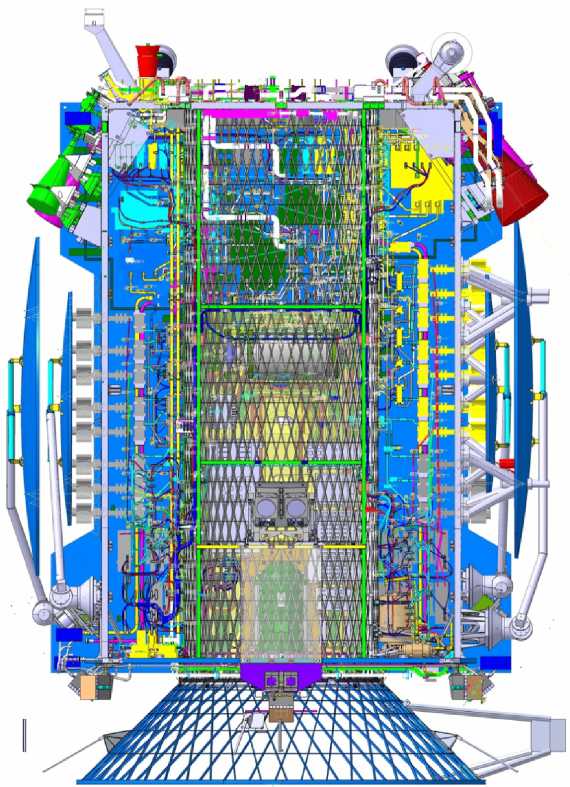
Рис. 1. Адаптер для вывода спутников системы ГЛОНАСС
Fig. 1. Adapter for displaying satellites of the GLONASS system
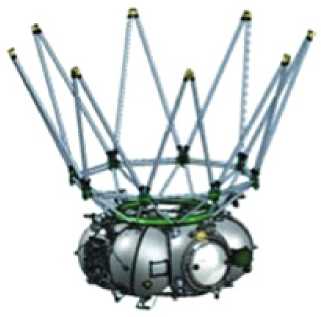
Рис. 2. Ферменная конструкция разгонного блока типа «ФРЕГАТ»
Fig. 2. Truss structure of the FREGAT type upper stage
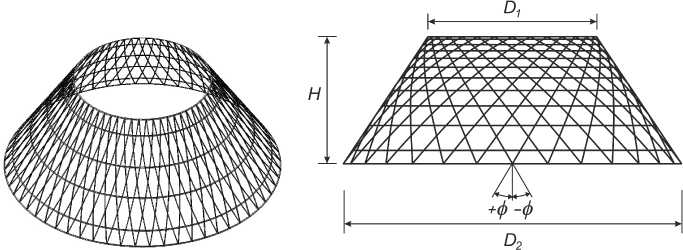
Рис. 3. Геометрическая модель сетчатой конической оболочки
Fig. 3. Geometric model of anisogrid conical shell
The optimal design parameters are determined based on the results of a comprehensive numerical experiment. It involves performing a series of typical calculations with different combinations of design parameters. Therefore, first of all, an algorithm and a program for constructing geometric and finite element models in automatic mode are developed in the environment of the integrated package (COSMOS/M).
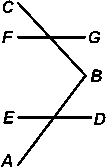
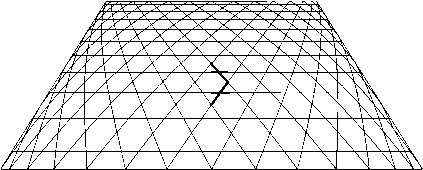
Рис. 4. Типовой элемент сетчатой структуры конической оболочки
Fig. 4. Typical element of the anisogrid conical shell structure
The basic design parameters of anisogrid conical shells include:
-
– base diameters and shell height;
-
– number of spiral ribs;
-
– orientation angle of spiral ribs on a large base;
-
– rib cross-section dimensions;
-
– material properties.
For a certain type of calculation, it is possible to automate the assignment of loads and boundary conditions (Fig. 5).
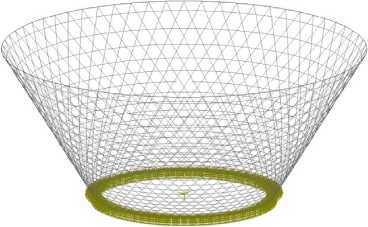
Рис. 5. Модель сетчатой конической оболочки с закрепленным малым основанием
Fig. 5. Model of anisogrid conical shell with a fixed small base
For fixed overall dimensions of an anisogrid conical shell, the most important parameters affecting the load-bearing capacity are the winding angles, the number and size of the cross-section of the spiral ribs.
Changing the winding angles of the ribs significantly affects the load-bearing capacity of the shells. This is, in particular, clearly visible in the results of a numerical experiment performed when analyzing the stability under axial compression of anisogrid conical shells of different elongation (Fig. 6). The presented graphs show that for models of different dimensions there are their own optimal values of the winding angles of the spiral ribs, minor deviations from which lead to a significant decrease in the load-bearing capacity of the shells.
A large study of the stability of anisogrid conical shells with an end load on a small base and a fixed large base was carried out by the authors of the work [13].
It revealed the influence of various factors (winding angles, number and orientation of the crosssection of spiral ribs) on the bearing capacity of the shells under different loading options of the small base (Fig. 7).
In the case under consideration of the anisogrid conical shell model, when the small base is fixed and the large one is reinforced with a frame and loaded with concentrated forces and moments, some similarity in the influence of varying certain design parameters (for example, the value of the winding angles, the number of spiral ribs and the orientation of their cross-section) on the rigidity and loadbearing capacity of the structure should be expected. However, a separate complex numerical study is required for an accurate description of the trends based on the actual values of the critical load and natural vibration frequencies (stiffness analysis) and a new type of calculation scheme (see Fig. 5).
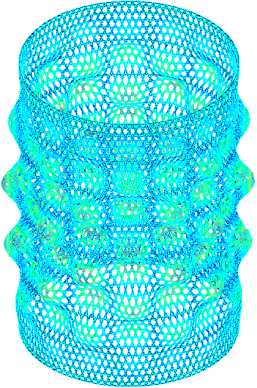
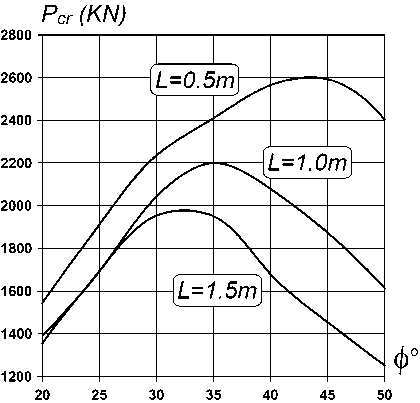
Рис. 6. Форма потери устойчивости цилиндрической сетчатой оболочки при осевом сжатии и графики зависимости критического усилия ( P cr) от величины углов намотки спиральных ребер (ϕ°) для моделей различной длины ( L )
Fig. 6. The form of buckling of a cylindrical mesh shell under axial compression and graphs of the dependence of the critical force (Pcr) on the magnitude of the winding angles of the spiral ribs (ϕ°) for models of various lengths ( L )
Numerical study
Different models differ in the angles of winding of the spiral ribs. In each individual case, the value of the orientation angle of the spiral rib relative to the generatrix of the conical surface is specified. This angle will be called the approach angle. The spiral ribs are laid along the geodesic lines of the conical surface. In this case, as they approach the small base, the orientation angle of the ribs increases (according to Clairaut's law). In the limiting case, the orientation angle on the small base is 90°. The approach angle has the maximum possible value. With the selected ratio of the diameters of the cone bases (D1/D2 = 2), the maximum value of the approach angle (φ) is 30°.
As the approach angles increase, the density of the grid at the small base increases (Fig. 8). Accordingly, the mass of the structure also increases.
The first study is related to the analysis of the rigidity of the structure, which is estimated by the value of the lowest frequencies of natural oscillations. The modes of bending, longitudinal, shell (Fig. 9) and torsional oscillations (around the longitudinal axis of the cone) were considered.

Рис. 7. Расчетные схемы (слева) и формы потери устойчивости (справа) в анализе устойчивости сетчатой конической оболочки с вариантами торцевой нагрузки на малом основании и закрепленным большим основанием

Fig. 7. Design diagrams (left) and buckling modes (right) in the stability analysis of a mesh conical shell with end load cases on a small base and a fixed large base
Let us analyze models with five fixed values of the approach angle (φ = 11°, 14°, 17°, 20° and 23°). This is enough to track the trends.


Рис. 8. Модели с различными значениями углов намотки спиральных ребер
-
Fig. 8. Models with different winding angles of spiral fins
It was revealed (Table 1) that the rigidity of the structure for two types of vibrations (bending and torsional) increases as the grid becomes denser, the shell rigidity remains almost unchanged, and the longitudinal rigidity decreases. This is explained by the large values of the longitudinal rigidity of the shell in the model with small orientation angles of the spiral ribs.
Table 1
Natural oscillation frequencies and safety factors of anisogrid conical shells with different winding angles of spiral ribs
|
φ, degree |
m, kg |
Natural oscillation frequencies, Hz |
Margin of stability, K, P = Kmg |
|||
|
bending |
torsional |
shell |
longitudinal |
|||
|
11 |
39.02 |
22.24 |
34.86 |
58.56 |
146.81 |
316.6 |
|
14 |
41.95 |
27.02 |
43.53 |
59.04 |
139.90 |
418.1 |
|
17 |
45.22 |
31.20 |
51.88 |
59.40 |
131.83 |
525.8 |
|
20 |
49.58 |
33.77 |
59.21 |
59.43 |
120.66 |
632.2 |
|
23 |
56.01 |
34.55 |
65.72 |
59.14 |
107.52 |
735.2 |
In parallel, the stability of the shell under longitudinal compression by an axial inertial load was investigated. The shape of the loss of stability (Fig. 10) shows that the loss of stability occurs according to the beam type with deformation of the rib sections in the zone with a low anisogrid density at the large base. An increase in the number and power of the ribs would contribute to an increase in the critical force, so that buckling occurs according to the shell shape, as in the models in Fig. 7.
With an increase in the approach angle φ = 11° to φ = 23° in our model, the critical axial load increases by almost 2.5 times (see Table 1, last column). This occurs due to the shortening of the rib sections in the danger zone.
The effect of anisogrid thickening (due to an increase in the approach angle φ) and the transition of the beam local form of stability loss to the shell form is clearly visible in the study of the stability of the shell under loading by a transverse force on a large base (Fig. 11). The critical values of the force (Table 2) in the models with approach angles φ = 11° and φ = 23° differ by more than 5 times.
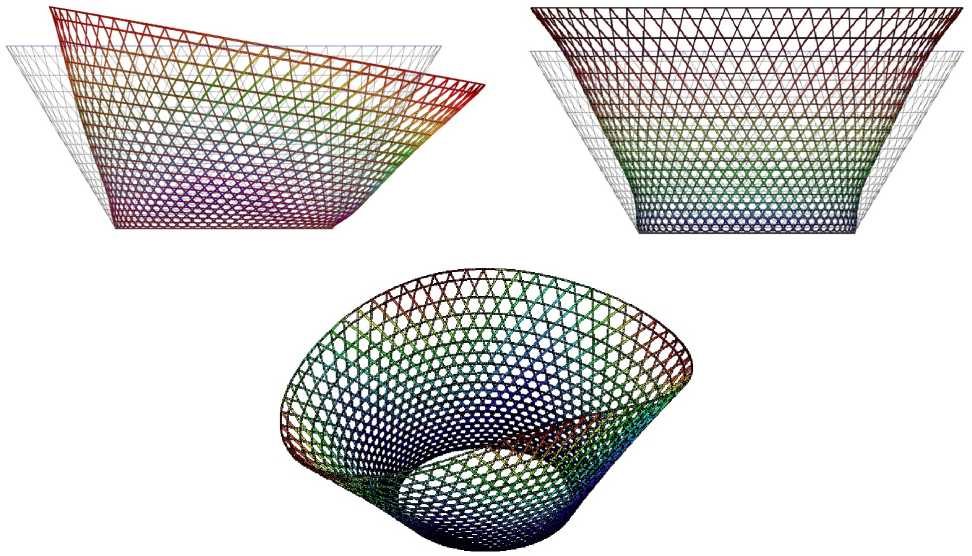
Рис. 9. Моды колебаний: изгибных, продольных и оболочечных
-
Fig. 9. Vibration modes: bending, longitudinal and shell

Рис. 10. Форма потери устойчивости при воздействии осевой перегрузки
-
Fig. 10. Form of buckling under axial overload
Table 2
Safety factor for loading with transverse end force in models with different winding angles of spiral ribs
|
φ, degree |
m , kg |
К 103 |
|
11 |
39.02 |
284 |
|
14 |
41.95 |
528 |
|
17 |
45.22 |
864 |
|
20 |
49.58 |
1.289 |
|
23 |
56.01 |
1.519 |
The same tendencies (Table 3) were found in stability problems under end loading on a large base with a bending moment (Fig. 12). Here, a denser anisogrid, as in the case of axial loading, is preferable. The forms of loss of stability of anisogrid conical shells with different angles of entry of spiral ribs are similar to that shown in Fig. 12 for the model with φ = 11°. The transition to the shell form of loss of stability and, consequently, an increase in the critical load can be achieved by increasing the number of spiral ribs and their power.
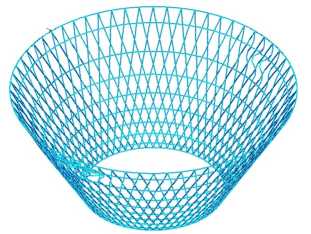

φ = 11°
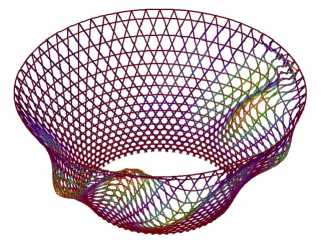
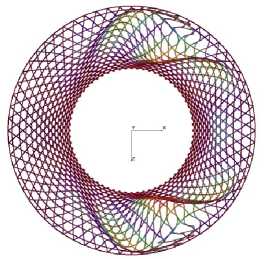
Рис. 11. Формы потери устойчивости моделей с углами захода φ = 11° и φ = 20° при нагружении поперечной силой на большом основании
φ = 20°
Fig. 11. Forms of buckling of models with approach angles φ = 11° and φ = 20° when loaded with lateral force on a large base
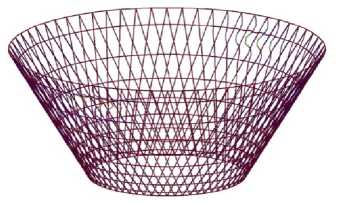
Рис. 12. Форма потери устойчивости модели с углом захода φ = 11° при нагружении изгибающим моментом на большом основании
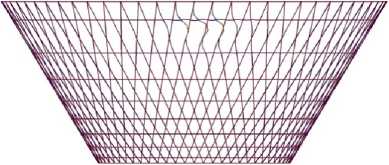
Fig. 12. Buckling mode of a model with an approach angle φ = 11° when loaded with a bending moment on a large base
Safety factor for bending moment loading in models with different winding angles of spiral ribs
Table 3
|
φ, degree |
m , kg |
К 103 |
|
11 |
39.02 |
449 |
|
14 |
41.95 |
771 |
|
17 |
45.22 |
1.030 |
|
20 |
49.58 |
1.290 |
|
23 |
56.01 |
1.555 |
Similar patterns (Table 4) are observed in the study of stability under end loading with torque
(Fig. 13).
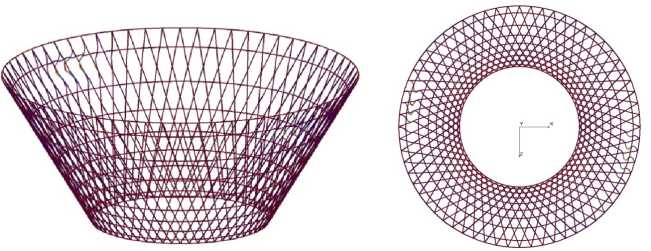
Рис. 13. Форма потери устойчивости модели с углом захода φ = 11° при нагружении крутящим моментом на большом основании
Fig. 13. Buckling shape of a model with an approach angle φ = 11° when loaded with torque on a large base
The forms of loss of stability of shells with different angles of entry of spiral ribs correspond to that shown in Fig. 13 for the model with φ = 11°. This is the form of local loss of stability. By varying the number of spiral ribs, the height and width of their section, and also the angle of entry, it is possible to bring it to a shell form, thus increasing the specific values of the critical force.
Table 4
Safety factor for torque loading in models with different winding angles of spiral ribs
|
φ, degree |
m , kg |
К 103 |
|
11 |
39.02 |
471 |
|
14 |
41.95 |
837 |
|
17 |
45.22 |
1.318 |
|
20 |
49.58 |
1.927 |
|
23 |
56.01 |
2.405 |
The following modal study was conducted for an anisogrid conical shell with a fixed small base and a specified load of 5225 kg on the free (large) base. As before, the shell rigidity and load-bearing capacity under axial overload were investigated. The behavior of the obtained parameters: frequencies of natural vibrations of various types (see Fig. 9) and critical values of axial overload (Table 5) are influenced by the mutually inverse tendencies of change in longitudinal and bending rigidity: as the approach angle φ increases, the bending rigidity increases, and the longitudinal rigidity decreases. In the general case, an increase in the approach angle φ is also advisable for increasing the critical force from axial overload, which for two model variants (φ = 11° and φ = 23°) differs by 4 times.
The analysis of the results obtained in the numerical experiment (Tables 1–5) shows that the non-load-bearing capacity of anisogrid conical shells, the small base of which is fixed and concentrated forces and moments are applied to the larger one, depends on the winding angle of the spiral ribs. In this case, the largest critical load values correspond to models with the largest approach angle, in which a finer anisogrid structure is formed and shell forms of loss of stability are realized. However, the conclusion that anisogrid conical shells with large winding angles are always preferable is generally incorrect. The data in Tables 1 and 5 indicate that the longitudinal rigidity is higher in models with small winding angles of the spiral ribs, and if this parameter is regulated, it is necessary to choose precisely such models, which are also significantly lighter than shells with large winding angles.
Table 5
Frequencies of natural oscillations and safety factors of anisogrid conical shells with a load on a larger base and different winding angles of spiral ribs
|
φ, degree |
m , kg |
Natural oscillation frequencies, Hz |
Safety factor |
||
|
bending |
torsional |
longitudinal |
|||
|
11 |
39.02 |
9.76 |
15.25 |
65.14 |
1.44 |
|
14 |
41.95 |
11.89 |
19.05 |
62.12 |
2.43 |
|
17 |
45.22 |
13.71 |
22.71 |
58.55 |
3.60 |
|
20 |
49.58 |
14.84 |
25.93 |
53.60 |
4.86 |
|
23 |
56.01 |
15.19 |
28.79 |
47.79 |
5.61 |
In addition, as shown by the calculations of the stress-strain state (SSS) (Fig. 14) of anisogrid conical shells loaded with a bending moment at the free (larger) end, the maximum equivalent stresses were realized in the model with a denser anisogrid (φ = 23°), and the minimum ones in the model with an approach angle of φ = 14°, and the difference in these stresses exceeded 50% (Table 6).
Table 6
Values of maximum von Mises stresses in models with different winding angles of spiral ribs under loading with a bending end moment
|
φ, degree |
m , kg |
von Mises stress, MPa |
|
11 |
39.02 |
432.28 |
|
14 |
41.95 |
382.94 |
|
17 |
45.22 |
402.55 |
|
20 |
49.58 |
479.44 |
|
23 |
56.01 |
612.72 |
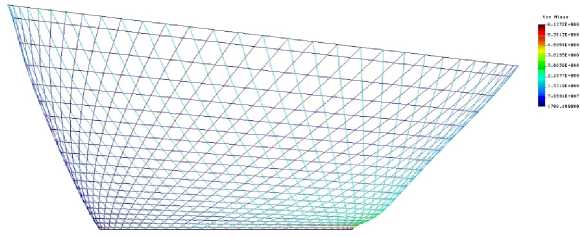
Рис. 14. Распределение эквивалентных напряжений в модели с углом захода φ =23° при нагружении изгибающим моментом на большом основании
Fig. 14. Distribution of equivalent stresses in a model with an approach angle φ = 23° when loaded with a bending moment on a large base
Conclusion
As a result of the work, the dependencies of the values of critical forces, rigidity parameters and stress-strain state of anisogrid conical shells fixed by a small base and loaded with force factors on a large base were determined. The study demonstrated the need for a comprehensive numerical experiment at the design stage of anisogrid composite power structures to determine the optimal combination of numerous design parameters. Since this combination is almost always unique (corresponds to certain, each time different performance characteristics), the traditional task of designing elements of the rocket and spacecraft design increases to the scale of scientific research.

